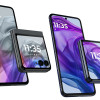Hands-On: Samsung Galaxy S II and Epic 4G Touch
Samsung re-announced the Galaxy S II with a lot of hullaballoo today in New York City, despite the fact that the device was actually announced in Barcelona seven months ago.
The S II for AT&T is amazingly thin. It is about as thin as they come. Samsung used a special, new Super AMOLED Plus display that itself is thinner than previous displays. It is also light as a feather. I can't recall a device that weighed as little as the S II. It'll slip into the tightest pocket.
As far as feel in the hand is concerned, its it doesn't feel all that different than some of the other Galaxy handsets out there, such as the Infuse 4G on AT&T's network. Because of the huge display, it is an enormous phone and very wide. It's near impossible to get your hand all the way around it. The back has a textured surface that reminds me of carbon fiber. The one bummer is that the S II still has that plastic-y feel of its Galaxy S predecessors. I would prefer it to feel more solid and seem some metal in the design somewhere rather than all the plastic that is used in the housing. For whatever reason, Samsung seems to be averse to using metal in its handset designs.
The Super AMOLED Plus display is ridiculous. It simply looks fantastic. Even in blinding white light, the display dazzled with its colors, brightness and clarity. Samsung really knows how to make fantastic displays on its devices. Oddly, the AT&T version of the S II has a 4.3-inch display, whereas the other two versions shown off tonight have 4.52-inch displays. AT&T wasn't able to explain the difference.
The rest of the S II takes a minimalistic approach. Thankfully, Samsung whittled the bezel down to almost nothing and the display fills most of the face of the phone. The power/lock key is on the right, the volume toggle is on the left, and there are the usual four buttons below the display.
The user interface builds on Samsung's TouchWiz software, but also tones TouchWiz down a bit. The main menu looks and acts just like other Galaxy TouchWiz phones, but the home screens are slightly different. Samsung has created its own widgets to collect information on the home screen. They can be used to stick all sorts of content from the web there, including RSS feeds, weather, news, email, social networks, and so on. The design of these widgets is clean and crisp, though it is easy to clutter up the home screen if you stuff too many on there.
The newest version of TouchWiz gets rid of all the dippy-looking, chicklet-sized icons that I've disliked intensely of previous versions of TouchWiz. Instead, Samsung has allowed the UI to look like a more natural version of Android. While there's still a decidedly Samsung feel to the user interface, it is far, far less obnoxious than it is on other Galaxy devices.
Perhaps most interesting, the new TouchWiz adds the ability to adjust all the home screens at the same time. Pressing and holding the home screen brings up a new dashboard that lets users customize each of the home screens from one spot rather than adjusting each one-by-one.
The user interface was lightning fast. I was able to jump from app to app, from screen to screen, in a jiffy. With a dual-core 1GHz processor under the hood, it has plenty of power to get things done.
Aside from the slightly plastic feel to the Samsung Galaxy S II, it's a truly impressive phone. Well done, Samsung.



















 Review: Samsung Galaxy S II for AT&T
Review: Samsung Galaxy S II for AT&T
 Motorola Upgrades its razr Foldables Across the Board
Motorola Upgrades its razr Foldables Across the Board





